
The chestnut-capped brushfinch, is a Neotropical passerine bird in the New World sparrow Passerellidae

The thick-billed seedeater is a species of finch in the family Fringillidae. It is native to the Western High Plateau and Bioko, the Albertine rift montane forests and the East African montane forests
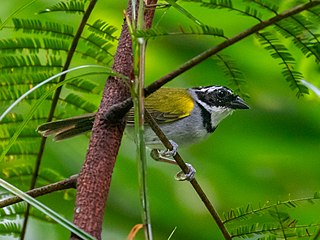
Arremon is a genus of neotropical birds in the family Passerellidae. With the exception of the green-striped brushfinch which is endemic to Mexico, all species are found in South America, with a few reaching Central America.
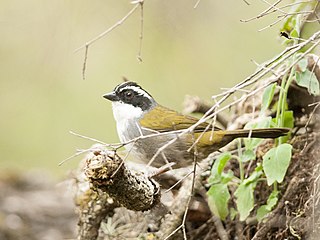
The white-browed brushfinch is a species of bird in the family Passerellidae. It lives in northwestern Argentina, Bolivia, and southern Peru. It is generally common in forest and dense second growth, mainly at altitudes of 2,000 to 3,000 metres, but locally it occurs at far lower altitudes. It previously was considered the nominate subspecies of the stripe-headed brushfinch.

The white-bellied robin-chat is a species of bird in the Old World flycatcher family Muscicapidae. It is found across the Western High Plateau, Bioko and the Albertine Rift montane forests. Its natural habitats are subtropical or tropical moist lowland forest and subtropical or tropical moist montane forest.

The olive finch is a species of bird in the family Passerellidae. Until recently, it was placed in the genus Lysurus.
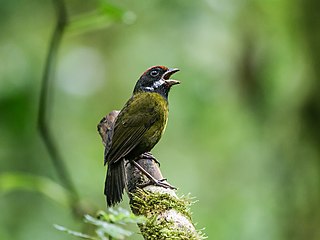
The sooty-faced finch is a species of bird in the family Emberizidae. Until recently, it was placed in the genus Lysurus.

The yellow-legged flyrobin or yellow-legged flycatcher is a species of passerine bird in the Australasian robin family Petroicidae. It is found in New Guinea and Cape York Peninsula. Its natural habitats are subtropical or tropical moist lowland forest and subtropical or tropical moist montane forest.

The canary flyrobin, also known as the Papuan flycatcher, canary robin, canary flycatcher, or montane flycatcher, is a species of bird in the family Petroicidae. It is found in New Guinea. Its natural habitat is subtropical or tropical moist montane forests with elevations from 1,100–3,500 m (3,609–11,483 ft). Currently, its population is believed to be stable.

The pygmy flycatcher, also known as the pygmy blue-flycatcher, is a bird species of the family Muscicapidae.

The yellow-cheeked tit is a species of bird in the family Paridae.
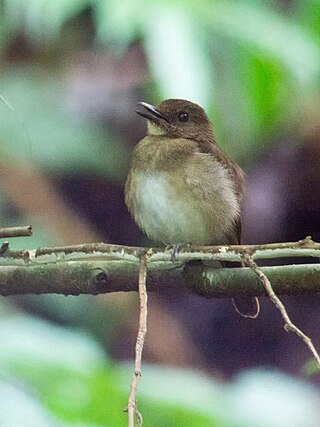
The white-throated jungle flycatcher, also known as the Negros jungle flycatcher is a species of bird in the Old World flycatcher family Muscicapidae. It is endemic to the Philippines and formerly on Guimaras before its extirpation there. The natural habitats of the white-throated jungle flycatcher are tropical moist lowland forests and tropical moist montane forests at altitudes of up to 1,350 meters. It is threatened by habitat loss.
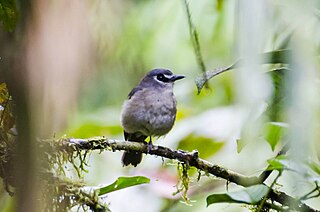
The slaty-backed jungle flycatcher, also known as the Goodfellow's jungle flycatcher or the Mindanao jungle flycatcher is a species of bird in the Old World flycatcher family Muscicapidae. It is endemic to the Philippines found only on the island of Mindanao. The specific epithet honours the British zoological collector Walter Goodfellow. Its natural habitat is tropical moist montane forests. It is threatened by habitat loss

The white-browed jungle flycatcher, also known as the Luzon jungle-flycatcher and the Rusty-flanked jungle-flycatcher, is a species of bird in the Old World flycatcher family Muscicapidae. It is endemic to Luzon island, in the Philippines. The natural habitat of the white-browed jungle flycatcher is tropical moist montane forests of the Cordillera Mountain Range and possibly Sierra Madre Mountains. It is threatened by habitat loss.
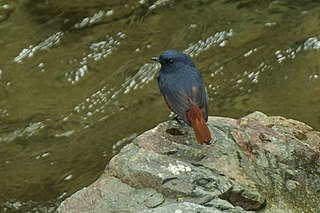
The Luzon water redstart, also known as the Luzon redstart, is a species of bird in the family Muscicapidae. It is endemic to the Philippines found primarily on Luzon with no records in Mindoro since 1965. Its natural habitats are tropical moist lowland forest, tropical moist montane forest, and rivers. It is threatened by habitat loss.

The blue-and-yellow tanager is a species of bird in the tanager family Thraupidae.

The grey-winged cotinga is a species of bird in the family Cotingidae. It is endemic to Brazil where it is restricted to the Serra dos Órgãos and Serra do Tinguá in Rio de Janeiro State. Its natural habitat is tropical moist montane forest.
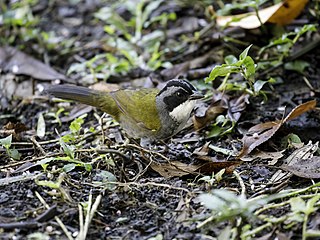
The Costa Rican brushfinch or grey-striped brushfinch is a species of bird in the family Passerellidae. It lives in the undergrowth of humid forest, especially near the edges, at altitudes of 300 to 1,200 metres in Panama and Costa Rica.

The black-headed brushfinch is a species of bird in the family Passerellidae. It lives in the undergrowth of humid forest, especially near edges, at altitudes of 300 to 1,200 metres in Colombia and Panama.
The Guerrero brush finch is a species of New World sparrow that is endemic to Mexico. The species was named in honor of Mr. Carl Kuehner, a member of the board of directors of the U.S. National Fish and Wildlife Foundation.





















